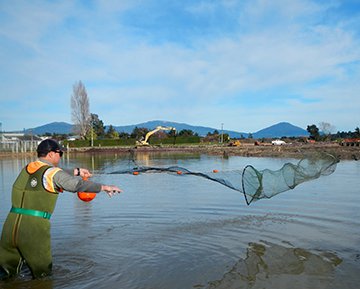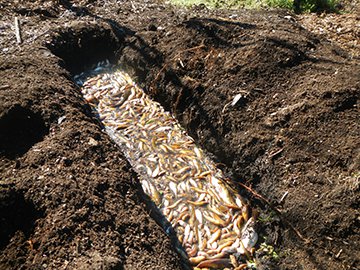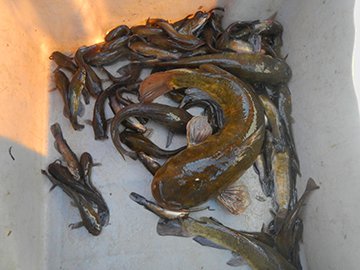Motuoapa Marina Fish Salvage
By Thomas Scott-Simmonds
Senior ranger, Supervisor Taupo Fishery - Kaitauawhi, Āo Hākinakina


Images above: (left) Casting the fyke net. (right) 6000 catfish to be repurposed as fertiliser.
Recently, the Department of Conservation (DOC) was approached by the Department of Internal (DIA) Affairs to assist with the much anticipated Motuoapa marina redevelopment. As part of their consent requirements from Waikato Regional Council, DIA were required to eradicate any pest fish species from the Motuoapa Marina Basin, and also safely relocate any trout. Due to the DOC Fishery’s experience and appetite in eradicating catfish and catching trout, we were more than happy to help out.
The process began with a site visit where the extent of the project became evident. The earthworks had been ongoing for several months prior, with the marina basin being blocked off via a dam ensuring no further fish escapement from the basin. Several large volume pumps were used to lower the basin water level enough to enable excavating. Often, the pumps were running 24/7 to control the ground water seepage and rain water which was topping the basin up continually. It was deemed unlikely that the basin would ever be completely dry, but estimates were made that it may get to a depth of 0.5m.
After further investigation of the site, it was clear there would be several hindrances. Potential methods such as backpack electric fishing were quickly thrown out the door as the basin floor proved very sludgy, making it difficult to navigate by foot. This, together with elevated turbidity and low water levels also prevented any boat-mounted electrofishing (stun-boat). Thick patches of macrophytes attached to the basin floor also proved a limiting factor when considering drag nets. However, with all things considered a strategy was formed to align the fish salvage with the ongoing earthworks programme.
The favoured method was the use of fyke nets. Fyke nets are essentially a type of cylindrical fish trap which contain a series of funnel-shaped openings making it easy for fish to enter the trap, but very difficult for them to make their way out. One or more vertical sections of netting, called leaders, extend from the mouth of the fyke net and guide swimming fish into the net. Fyke nets are considered a type of passive sampling gear because they rely on fish to willingly encounter and enter the net. It is a tried-and-tested method that the DOC Fishery currently implement when conducting our annual catfish monitoring programme over the summer months. They are also known to catch a variety of other species including trout, Koura, Koaro and goldfish. However, based on our observations and sample fyke net catches, we assessed the marina as being very unlikely to hold any significant populations of desirable species such as trout or native fish such as Koura and Koaro.=
A bund was then created which divided the marina into two separate water bodies. The plan was to supersaturate each ‘cell’ with numerous fyke nets when at its lowest to assist in congregating any fish. The nets were set along the deepest sections of the existing channel. The theory being that if any trout were present they would be residing in the deepest sections as this would serve as a thermal refuge. Once the first cell was sufficiently netted, the second cell would then be pumped and the process repeated.
Fish capture for the first cell is now complete with the second cell soon to be started. So far, the DOC Fishery team has set a total of 6 fyke nets over a period of 240 hours, or equivalent to 10 days/nights. A total of approximately 6,000 catfish, 4 small goldfish and 5 Koura were caught. The catfish ranged in size from 60mm to 270mm. Of these, approximately 98% were considered juvenile and were primarily caught in one area – at the end of the boat ramp which was one of the deeper locations. No trout or Koaro were seen or caught.
The Koura and goldfish were retained for our freshwater aquarium at the Tongariro National Trout Centre, and the catfish were all destroyed using a water dispersible, liquid anaesthetic, before being taken to a local organics farm for use as compost.
When comparing the recent marina catch to the average number and size observed when conducting our catfish monitoring programme, it is apparent that the marina may have been assisting in providing a nursery habitat. Although this exercise has been a great opportunity to remove these pest fish, it does however provoke a new line of thinking in regard to the movements, preferred habitats for juveniles, and possible management plan of the Bullhead catfish in Lake Taupo.
If you would like to see one up close pop down to the Tongariro National Trout Centre where we have some on show in our freshwater aquarium.
Image below: Brown bullhead catfish.

Specie overview
The Brown Bullhead catfish Ameiurus nebulosus is thought to have been present in Lake Taupo since the early 1980’s. The introduction of catfish, either deliberate or accidental has caused widespread concern over the potential impacts on the Taupo trout fishery, and the sustainability of the lake ecosystem. In response, an MSc thesis on the biology of catfish was undertaken in 1995 and a monitoring programme studying the population dynamics of catfish was initiated in December 1996 by the Department of Conservation.
Distribution: Catfish are distributed around the entire Lake Taupo, inhabiting weedy, rocky and sandy environments. The greatest density of catfish has been shown to occur along the weedy margins of the lake’s southern shores (Barnes 1996) and in shallow water (Dedual 2001). They are relatively depth limited with acoustic tracking indicating a maximum depth of 17m (Dedual 2001). Stables & Thomas (1992) observed a similar depth preference pattern.
Diet: In Lake Taupo, gut analysis (when not empty) generally shows snail and plant material present. Barnes (1996) found that bullhead catfish in shallow, weedy, or rocky habitats did not include trout in their diet and that crayfish were a rare item found in their stomach.
References
Barnes, G. E., 1996. The biology and general ecology of the brown bullhead catfish (Ameiurus nebulosus) in Lake Taupo. Unpublished MsC thesis, University of Waikato, Hamilton, N.Z.
Dedual, M., 2001. Vertical distribution and movements of brown bullhead catfish (Ameiurus nebulosus) in Motuoapa Bay, southern Lake Taupo, New Zealand. Department of Conservation, Turangi, N.Z.
Stables, T. B. & G. L. Thomas, 1992. Acoustic measurement of trout distributions in Spada Lake, Washington, using stationary transducers. J. Fish Biol. 40: 191-203.